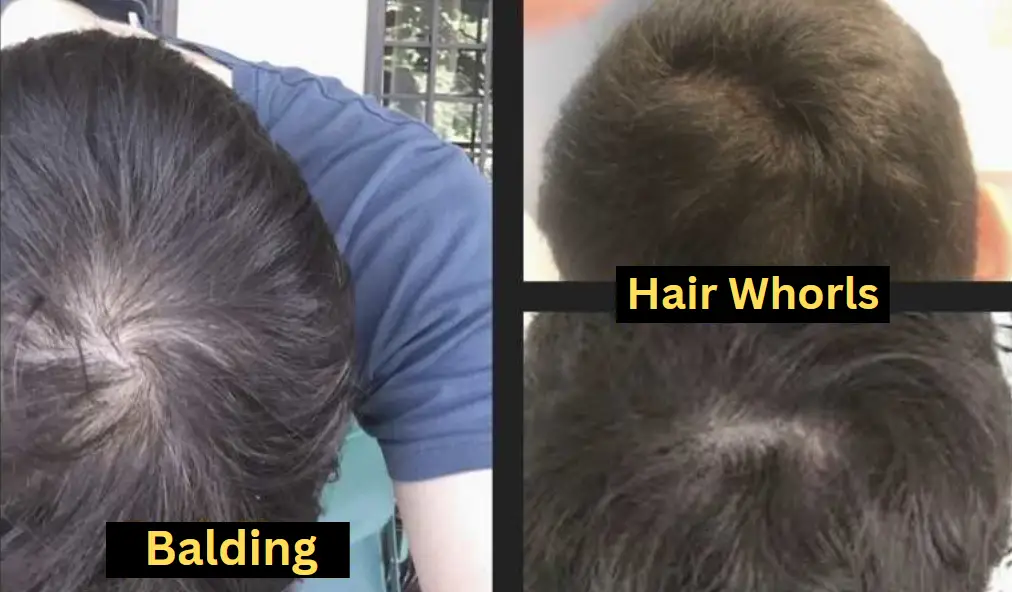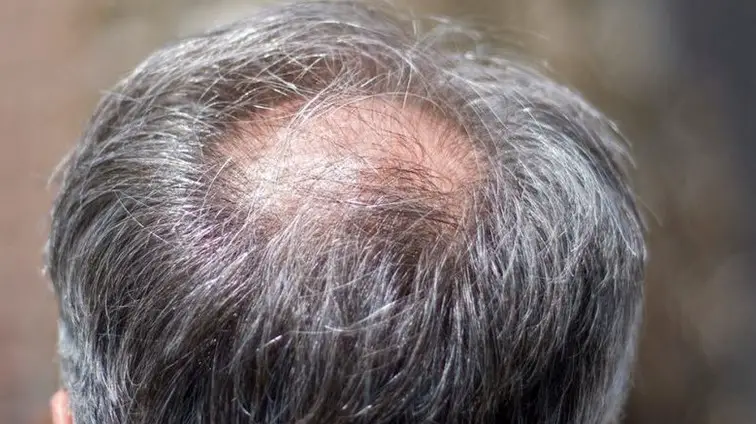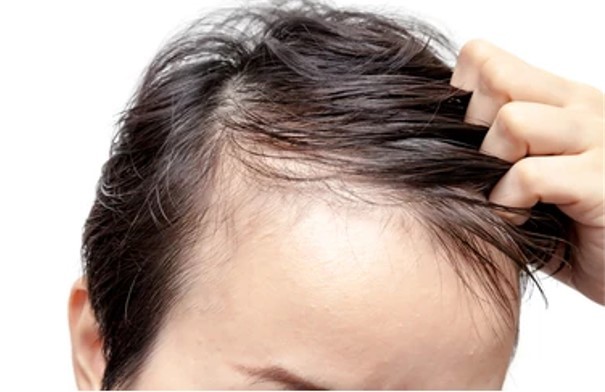The hair whorls, and balding are not the same. Hair whorls are a normal pattern of growth in hair that people inherit from birth, and balding is a result where hair loss can be caused by male pattern genetic hair loss or other causes. So while a hair whorl might occasionally create the appearance as if it’s a bald spot, they’re not exactly the same.
However, if you are concerned that you may have spots of hair loss on the crown of your scalp? The truth is, there’s no reason to worry. It is normal for individuals to lose 100-150 hairs per day. And it’s common in the case of scalp hair to become exposed in the area of the whorl as opposed to other areas of the scalp. This is only an issue when your hair loses its volume faster than normal and stops growing back. In the following article, we’ll attempt to answer some of the most commonly asked inquiries about hair whorls and how they can be treated by Dr Ljuba Zsolnai, who revolutionized whorl hair growth for those with back-of-the-head bald spots.
Hair Whorls or Balding/Bald Spots What’s the Difference?
The hair that develops in a circular pattern around a centre point visible in the hair is known as hair whorl. Every person has a whorl of hair located on the crown of their scalp, and for the majority of part, they develop clockwise or counterclockwise.
Many people describe hair-loss whorls as “bald spots,” but technically, they’re not identical. The majority of bald spots are caused by male pattern genetic hair loss. Hair follicles are weakened by this hormone called DHT which causes them to cease to grow. In certain instances, bald spots could be caused by alopecia areata, an auto-immune disorder that causes hair loss in tiny patches. The most prominent symptoms of this condition are patchy hair loss, but the amount of hair that is lost and regrows differs between individuals.
A more exposed head around the whorl shouldn’t be something you need to worry about. This is because the whorl’s direction on your head can change 360 degrees. The angle at which hair emerges from your scalp also decreases. This means that hair is flat on the curvature of the crown. There are no issues if you don’t show any clear indications of hair loss around the whorl. If you notice a change over time or are concerned, seek advice from an experienced medical professional.
Here you can learn more about cowlick or balding.
The Challenge in Crown Whorl Reconstruction
Hair transplants do not just involve removing the donor’s hair and transferring the hair grafts to specific regions of the scalp where bald spots or hair loss occur. Instead, it is about reproducing the differences between the whole structure and the hair’s design. This is the case for the natural design of the hair whorl the patient. While reconstruction of any type of receding hairline stages is more well-known, reconstructing the crown whorl can have the same aesthetic value and result in a more natural appearance after the hair transplant procedure.
Crown whorl shape and reconstruction are crucial in treating the problem of crown baldness. It is, however, particularly difficult for skilled surgeons. A well-constructed crown demands the surgeon’s expertise in the structure of hair as well as the art of it and the ability to repair the whorl. Certain surgeons won’t treat the crown, but the outcome of the hair transplant will be superior when the treatment is extensive enough to encompass the whorl. This is because it gives the appearance of a three-dimensional image when viewed from a perspective view, giving the patient an aesthetically pleasing result.
The direction of the hair also varies according to gender and race. Therefore, hair transplant surgery surgeons must be able to restore the correct whorl for the gender and race of the patient to ensure more natural-looking outcomes. Achieving an appearance that is natural hair restoration to cover bald spots requires a transplant surgeon with advanced expertise, experience, and artistic ability in restoring the crown whorl.
Do I have a balding or thin crown?
If you notice thinning hair or a spot of baldness in your head, this may indicate losing hair. However, it is advisable to seek a medical specialist to find out why your hair is lost. They can look at your scalp, go over your medical records, and run any tests needed to identify the root cause behind the loss of your hair. For example, in certain cases, hair loss on the crown might be caused by genetic male pattern baldness; however, in other instances, it could be due to other causes like food insufficiencies, stress or medical issues. Therefore, it is crucial to receive an accurate diagnosis to determine the most effective option for treatment.
Read more:
- I Can See My Scalp Through My Hair – Am I Going Bald?
- Thin crown | What Do You Recommend for Hair loss
- Signs Of Balding At 20
Hair Swirl Meaning
“hair” is a term used to describe “hair swirl”, which refers to an angular or spiral pattern of hair growth on your scalp. This is sometimes referred to as a cowlick or hair whorl. The cause is the direction in which hair follicles grow and can appear at any point on the scalp. Hair whorls may appear counterclockwise or clockwise. They are typically noticeable when the hair is raised or develops at a distinct angle from the other hair that surrounds it. Hair swirls are a common variation in human hair growth and aren’t usually related to any medical conditions or health issues.
What is Hair Whorl?
The hair whorl, a cowlick, creates an angular or circular pattern that grows locks on the scalp. It’s caused by the direction that hair follicles develop and can appear at any point on the scalp. Hair whorls may appear clockwise or counterclockwise. They’re typically noticeable when the hair is raised or develops differently from the hair surrounding it. They are a typical variation in human hair growth and aren’t usually related to any medical conditions or health issues.
The Ziering Whorl
Hair transplant specialists could transplant hair grafts to areas of baldness without paying attention to the hair style and design. Hair grafts were often transferred in straight lines, covering the entire area from the outside inside. However, this method produces results that are not natural, and hair loss remains evident within the crown.
To stop this from happening and to correct this practice, Dr Zsolnai conducted a study to standardize the language used to define hair whorl patterns and identify their anatomic positions. In the course of 534 people, Dr Zsolnai created an identification system and defined hair whorl differences according to ethnicity and gender. This classification system is called the Ziering Whorl.
By doing this, surgeons can help restore the natural movement of the whorl. It is possible to do this even if the whorl pattern has disappeared due to a loss of hair excessively.
The Ziering Whorl is now the most commonly used method of hair restoration to treat bald spots. This hair transplantation method is unique and efficiently replicates the natural movement of the whorl. Therefore, it is ideal for patients seeking more results from the hair transplantation procedure. By using The Whorl Form Surgical Method, Zsolnai surgeons can assist patients in attaining a higher hair transplant density in the crown region with more natural outcomes.
What is Crown Balding?
“Crown balding” is a word used to describe hair loss around the vertex of your scalp, the region near where your hair is at its highest. The loss of a portion or all of the hair that covers this area of the scalp can be among the most frequent symptoms of loss of hair pattern for males.
The baldness around your crown is typically due to male pattern baldness that can be because of a combination of genetic and environmental factors and the effects of dihydrotestosterone, also known as DHT.
In time, DHT can attach to hormone receptors on your scalp, causing hair follicles and shafts to shrink. As follicles get smaller and cease producing hairs capable of reaching the outside layer of your skin.
This usually starts at the hairline and your crown and leads to the typical diminishing line of hair and bald patch most men suffering from male pattern baldness will eventually see on the outside of their mirrors.
Although most cases of hair loss are due to male pattern baldness, a few may occur due to other types that result in hair loss.
Other causes of hair loss that could affect hair growth around the crown are:
- Alopecia areata is a form of hair loss caused by damage to your immune system to hair follicles.
- Telogen effluvium is a type of hair loss triggered by illness, stress or other conditions that cause food insufficiencies, fever and other conditions.
- Traction Alopecia is hair loss caused by products and hairstyles pulling hair follicles.
- Tinea capitis is a type of hair loss that could result from an infection caused by fungal bacteria on your scalp.
- Cicatricial hair loss ( scarring alopecia) is a type of loss of hair when scar tissue grows over the hair follicles.
Hair loss may result from certain medications like anticoagulants and thyroid medication.
How to deal with the balding
The best way to avoid hair loss is to adopt an active approach. If you do not wait until you’ve lost the bulk of your hair or exhibited an extremely receding hairline before you begin taking action, you will likely achieve the outcomes you’d like to see.
However, it is important to act immediately if you spot an increase in hair loss will help you keep the majority or all of your hair.
One of the main reasons men allow their hair to fall out untreated is to deny the seriousness of their loss.
Loss of hair can occur to men at any stage of their life. However, if you are in your 40s or 50s, 60s and 70s, or even in your teens or early 20s, consequences of male pattern baldness may be present and negatively impact the thickness of your hair and density.
If you observe a larger-than-usual volume of hair on your pillows or in the drain of your shower, It’s essential to act quickly.
Start Using Hair Regrowth Products
Today, the most effective approach to combat hair loss is to use medications to stop DHT from destroying the hair follicles and stimulate the growth of new hair.
The FDA has approved two drugs for treating hair loss -the over-the-counter topical medicine minoxidil and the oral prescription medication finasteride.
Minoxidil, available in the form of foam and liquid and foam, can be believed to function (its specific mechanism of action isn’t completely comprehended) by increasing blood flow to your scalp and shifting hair to the anagen stage of the cycle for hair growth. It’s typically applied twice daily to areas on your scalp showing signs of loss.
Finasteride is effective by halting testosterone’s conversion to DHT, the hormone responsible for male pattern baldness.
We provide minoxidil solutions, minoxidil foam and finasteride on the internet and a hair Power Pack that includes both drugs.
Schedule a Consultation at Dr Zsolnai Medical
Dr Zsolnai is a leading hair transplant surgeon and is constantly researching methods and treatments to improve the level of satisfaction for patients. Along with his surgical team, Dr Zsolnai can help you get back your naturally youthful, healthy hair that you previously had. For better hair confidence, schedule a consultation at Zsolnai Medical. Our team is more than willing to offer the best treatments for you. Dr Zsolnai is Europe’s top clinic in hair transplantation. She has each year helped around 200 British patients resolve their hair loss issues.
- AI Powered Bald Filter Online 2024: See Yourself with No Hair! - January 19, 2024
- Harklinikken Bad Reviews 2024: Analyzing Negative Feedbacks - January 18, 2024
- How to Get the Alex Eubank Hair | Step-By-Step Tutorial 2024 - January 18, 2024









